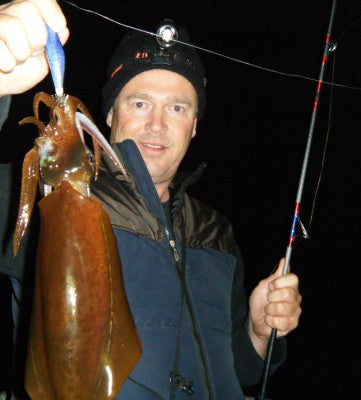 Who wants to go “Squid Fishing” sure did get a few strange looks when I asked my fishing buddies this question. They looked at me with dis-belief, why would you want to catch squid.
Who wants to go “Squid Fishing” sure did get a few strange looks when I asked my fishing buddies this question. They looked at me with dis-belief, why would you want to catch squid.
I had the same sort of reaction in myself when I heard people getting into this sport. They don’t fight very hard there small and they look weird.
However, I had a go and the first few times I did not catch much. When I did crack the code and catch one I was overcome with a feeling of euphoria, it was the same type of feeling I got when I first caught a snapper on a jig or more recently when I first caught a snapper on Softbait.
I wanted more, it is fun getting out at night time standing on the rocks or a wharf with your buddies chewing the fat while waiting for a squid to come along and hit your lure. I have become fully addicted to catching squid, I am always talking about it and thinking about it, maybe because it’s something of an unknown, you have to rethink your strategies become a sponge for information and are prepared to fork out for more cash for rods, reels and lures.
Yes, squid fishing like any other form of specialist fishing has specialized gear that will increase your chances of catching more squid and enjoying the catching process more. Sure, you can use the gear you already have but it won’t work as well as the proper equipment.
I have been catching squid from the land and also from the boat. In this article I will cover what I have learnt from fishing land based.
Firstly, there are the right rods to use. When I first started, I used my light Softbait set, but soon discovered it was too heavy and short and was a bit like fishing for snapper on a stand up marlin set.

Squid rods are very light and should weigh between 110-140 grams and be anywhere from 7 ½ feet up to 9’’ in length. They are made from carbon and are very delicate and can break if you use them for catching larger fish, so only use them for squid fishing. The good rods have low profile guides which are different than traditional spinning rods or soft bait rods. Squid rods really are a joy to use and do increase the enjoyment factor. I have been using a rod called a Calamari Stick which will be available here in NZ in a few weeks.
The ideal reels are small spinning reels and have low capacity spools which hold around 150M of braided line. The reels come in various qualities and you pretty much get what you pay for. I have seen low capacity expensive Stella reels on expensive rods and the combo can cost thousands. You can find good quality Squid rods for around $200.00.
PE braid line is the best to use fused braided lines do not work as well, there are PE Braid lines for squid fishing which will be available soon if not now. It is very fine and limp and of very high quality which is related to the price.
Light fluorocarbon leader is the standard for trace material. The size is around 6lb or so. The best knot to join the fluorocarbon to braid is a PR knot which is quite specialized; a back to back uni will also work.
There is a huge range of Squid Lures available in all colours of the rainbow and many different colour patterns as well. The best colours I have found are pinks and orange and also natural baitfish coloured lures. There are a few brands available make sure you purchase a quality brand as the cheap ones do not work as well. The lures come in different weights and picking the right one can be vital to your success. For example the three sizes I have been using are 2.5, 3.0 and 3.5 with 2.5 being the lightest and 3.5 the heaviest.

You need to select the right weight so your lure slowly sinks to the sea bed. It can make all the difference changing weights if you’re not catching much and this is also true for changing colours until you found out which one is working.
There are also two different textures available on squid jigs, one type has a cloth covering over the squid body which creates a texture and the other type is a smooth plastic finish usually made out of see through plastic with shiny internal inserts. I have been told to use the textured body lures at night and the shiny reflective clear plastic bodied versions in the daytime.
The life cycle of a squid is an interesting one as they only live for one year. They feed intensely for one year then lay their eggs and die, their size is determined by how much they eat. They can be very aggressive feeders there on a mission to get big, and they will attack lures. Sometimes you can see them competing for your lure when you’re retrieving, when this happens, let your lure sink as most of the time squid will take lures that are falling through the water column. It’s important to remember this when you are developing your technique.
The start of the season which is around April the squid tend to be smaller but as the season goes on and they eat more and more and the size of the squids increases, so the size of squid you catch generally increases as the season moves forward. The season starts in April and it ends in January. The season peaks from August to December and you can expect to catch the biggest ones in October and November. However as the size of the squid is determined by how much it can eat you can come across big squid throughout the season.
I have been using three different techniques which all require a different rig and are used in different situations.

The first and most successful technique is EGGING which is tying one squid jig on the end of your fluorocarbon leader. This is the technique experienced squid fishers use as it is very effective, however it does take some learning and requires good equipment.
The technique is to cast your lure out to where you think the squid may be, then let it sink down to a depth the squid is likely to be holding. When it has reached the required depth the angler whips his rod aggressively two to three times to get the lure to dart up through the water column and then let it fall back down to the required depth, the next step is a slow retrieve with a few twitches.
The idea is to vary the amount of sink them with the lure to see if you can determine if the squid are holding near the bottom, mid water or around the surface. Once you have figured this out you can keep your lure in the right zone by timing how long to let your lure sink before you whip your rod to twitch the lure up and keep it in the right zone. This method is fun and challenging. If you use the right rod you can actually feel if your lure has touched the bottom or is brushed over the top of seaweed which can be an advantage. You really do need a squid rod to be able to master this technique correctly.
The second technique I have been using is a float to hang your squid lure at the right depth; this is a popular method which is easier as you do not need to worry about timing your twitches to stop your lure from being snagged. If your fishing very shallow water this can be a good method to use. The floats are a specialist and you can rig them so you can adjust the distance from your lure to the float, they also have a hole so you can use a glow stick to see where the float is at night time which is vital.
The third rig I have been using is a type of squid lure ledger rig. I will use two squid lures rigged branched off the main line with a small ball sinker on the bottom, just like a ledger rig. This rig is good for Wharf fishing as you can cast it out and leave it. You will often see experienced squid fishermen using this technique and placing the rod against the wharf railing and using a second rod for Egging as described above.
There are a few fishing shops around that specialize in squid fishing, the guys I met in Glen field were very passionate about their squid fishing and very eager to help with rigs and techniques, they also go fishing together in groups and they don’t mind beginners tagging along.
You will find squid around the rocks and seaweed with a bit of current, they like to be able to hide from their prey and be able to stalk their prey. Look for these types of areas and give it a go. There are heaps of places to try and maybe you will be the first person to try and catch a squid in a spot you have in mind. I have caught squid in every place I have tried, so give your local spots a try. A telltale sign to look for is squid ink stains on the ground if you find these you know that squid have been caught here before.

I have found night time to be the most productive, however, I have heard a few catches in the daytime but it tends to be a nighttime activity.
When you catch a Squid be aware that they squirt ink out their back end so make sure you point it at your mate as if it gets on yourself, it will stain your clothes, they have a good aim so be aware of this.
The flavour of fresh squid is superb and I rate it up there with scallops and crayfish it tastes fantastic. To clean them you will need to remove the insides. Be aware there is an ink sack inside the squid and if you can remove the insides without damaging the sack you will create way less mess. I do this by running a butter knife around the inside of the tube to separate the insides from the squid tube wall, I then pull the insides out as one and also remove the cartilage spine which is like a clear piece of plastic that runs along the inside of the tube. Remove all the skin give it a good wash and cut it into strips or rings.
Catching squid is an absolute blast it’s addictive, challenging and a lot of fun. It makes for a good social time with mates and you don’t need a boat. It only takes a couple of hours after dinner to catch top quality seafood, have a go and see what you think.



Share:
Plenty of Variety on offer in the Far North.
Where to Catch Squid Around Auckland?